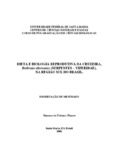| dc.creator | Nunes, Simone de Fátima | |
| dc.date.accessioned | 2006-11-24 | |
| dc.date.available | 2006-11-24 | |
| dc.date.issued | 2006-07-18 | |
| dc.identifier.citation | NUNES, Simone de Fátima. The diet and reproductive biology of the urutu (Bothrops alternatus) (serpentes Viperidae), in the Southern Region of Brasil. 2006. 68 f. Dissertação (Mestrado em Ciências Biológicas) - Universidade Federal de Santa Maria, Santa Maria, 2006. | por |
| dc.identifier.uri | http://repositorio.ufsm.br/handle/1/11178 | |
| dc.description.abstract | The Bothrops alternatus is a terrestrial pitviper of the Crotalinae sub-family, Bothriopsini tribe, measuring, approximately, 1690mm. It presents a vertical distribution of approximately 700 m above sea level, and is found in Brazil, Paraguay, Uruguay and Argentina. In Brazil, it is found in the states of Minas Gerais, Goiás, São Paulo, Paraná, Santa Catarina, Rio Grande do Sul and Mato Grosso. It inhabits swamps, marshes, riverbanks and other wet habitats, fields and rocky areas, as well as farmlands. In this study, 207 specimens of Bothrops alternatus were analyzed with the objective of broadening the knowledge available about its diet and reproductive biology in the southern region of Brazil. The analysis of the digestive tube content indicated that the species is a specialist in mammals (Muridae: 80,8 %, Caviidae: 9,6 %, and Didelphidae: 9,6%). Most of the snakes began ingesting the prey at the frontal region of their bodies (93,4 %). The reproductive cycle of this species is long. Vitellogenic follicles were found throughout the year, embryos from November to January, and births were registered in February, March, April, June and August. Males possess an aseasonal reproduction and reach sexual maturity with a shorter snout-vent length than females. The smallest mature male (enlarged and opaque efferent ducts) measured 438 mm in snout-vent length and the smallest female (follicles > 10 mm) measured 701 mm. Adult females storage spermatozoids in the uterus. The number of offspring varied from 5 to 20 and their snout-vent length varied from 146 to 252 mm. Mature females possessed a greater snout-vent length than mature males, but their tails were proportionately smaller. | eng |
| dc.format | application/pdf | por |
| dc.language | por | por |
| dc.publisher | Universidade Federal de Santa Maria | por |
| dc.rights | Acesso Aberto | por |
| dc.subject | Serpentes | por |
| dc.subject | Bothrops | por |
| dc.subject | Dieta | por |
| dc.subject | Reprodução | por |
| dc.subject | Sul do Brasil | por |
| dc.subject | Snakes | eng |
| dc.subject | Bothrops | eng |
| dc.subject | Diet | eng |
| dc.subject | Reproduction | eng |
| dc.subject | Southern Brazil | eng |
| dc.title | Dieta e biologia reprodutiva da cruzeira, Bothrops alternatus (serpentes Viperidae), na Região Sul do Brasil | por |
| dc.title.alternative | The diet and reproductive biology of the urutu (Bothrops alternatus) (serpentes Viperidae), in the Southern Region of Brasil | eng |
| dc.type | Dissertação | por |
| dc.description.resumo | Bothrops alternatus, serpente viperídea, subfamília Crotalinae, tribo Bothriopsini, apresenta hábito terrestre, medindo aproximadamente 1690mm. Sua distribuição vertical é de aproximadamente 700 m em relação ao nível do mar, ocorrendo no Brasil, Paraguai, Uruguai, e Argentina. No Brasil é encontrada em Minas Gerais, Goiás, São Paulo, Paraná, Santa Catarina, Rio Grande do Sul e Mato Grosso. Esta espécie habita áreas pantanosas, ribeirinhas, brejos e outros hábitats úmidos, campos e áreas rochosas além de áreas cultivadas. Neste estudo, foram analisados 207 exemplares de Bothrops alternatus com o objetivo de ampliar o conhecimento sobre a dieta e a biologia reprodutiva da espécie na região sul do Brasil. A análise do conteúdo do tubo digestório indicou que esta espécie é especialista em mamíferos (Muridae: 80,8 %, Caviidae: 9,6 %, e Didelphidae: 9,6%). A maioria das serpentes iniciou a ingestão pela região anterior do corpo da presa (93,4 %). O ciclo reprodutivo desta espécie é longo. Folículos vitelogênicos foram encontrados ao longo de todo o ano, embriões de novembro a janeiro, e nascimentos foram registrados em fevereiro, março, abril, junho e agosto. Machos possuem reprodução assazonal e atingem a maturidade sexual com comprimento rostro-cloacal (CRC) menor que fêmeas. O menor macho maduro (ductos deferentes enovelados e opacos) mediu 438 mm de CRC, e a menor fêmea madura (folículos > 10 mm), 701 mm. Fêmeas adultas estocam espermatozóides no útero. O número de filhotes variou de 5 a 20 e seu CRC de 146 a 252 mm. Fêmeas maduras possuem CRC maior que o de machos maduros, mas suas caudas são proporcionalmente menores. | por |
| dc.contributor.advisor1 | Cechin, Sonia Zanini | |
| dc.contributor.advisor1Lattes | http://lattes.cnpq.br/9682463613649812 | por |
| dc.contributor.referee1 | Santos, Selma Maria de Almeida | |
| dc.contributor.referee1Lattes | http://lattes.cnpq.br/2241377641978814 | por |
| dc.contributor.referee2 | Caceres, Nilton Carlos | |
| dc.contributor.referee2Lattes | http://lattes.cnpq.br/1920880712756721 | por |
| dc.creator.Lattes | http://lattes.cnpq.br/5017134585358647 | por |
| dc.publisher.country | BR | por |
| dc.publisher.department | Bioquímica | por |
| dc.publisher.initials | UFSM | por |
| dc.publisher.program | Programa de Pós-Graduação em Ciências Biológicas: Bioquímica Toxicológica | por |
| dc.subject.cnpq | CNPQ::CIENCIAS BIOLOGICAS::BIOQUIMICA | por |


